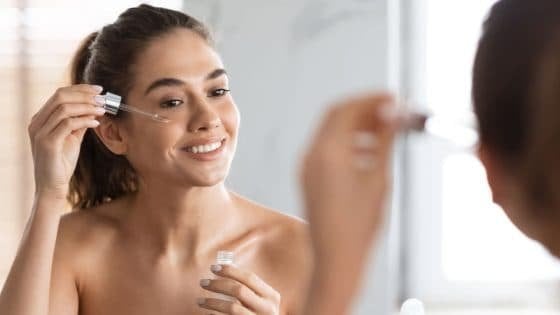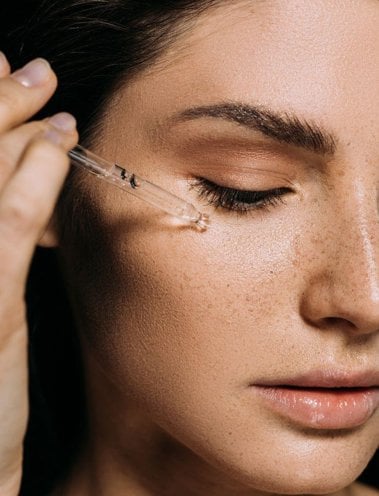Best Retinol Alternatives For Beginners & How To Use Them?

If you are a beginner with retinol or have sensitive skin, retinol alternatives or natural retinol are the things you might want to use.
Let’s find out what retinol serum does, its skin benefits, and which is the best natural retinol serum for beginners for you.

What do retinol alternatives do for the skin?
For our skin, retinol alternatives have several impressive and important functions, just like normal retinol:
● It regulates skin cells’ function and helps repair damaged cells. It also reduces water loss from the skin and improves blood flow.
● Collagen production is boosted, which enhances skin firmness, plumpness, and strength.
● It prevents collagen and elastin breakdown, helping to smooth wrinkles, fine lines, and sagging skin.
● Improved skin cell cellular turnover leads to smoother and more radiant-looking skin. In addition, it helps create an even skin tone, fades hyperpigmentation (brown marks and patches), and gives the complexion a more uniform appearance.
● By normalising overactive oil glands, retinol aids in the treatment of acne. And its exfoliating properties help to unclog pores, preventing and clearing blackheads, whiteheads, pimples, and cystic acne, refining pores and promoting a more even texture.
● It also helps fade post-inflammatory hyperpigmentation and improve acne scarring.
● In addition, its antioxidant properties help to reverse the effects of sun damage.
When should you start using retinol alternatives?
Skin experts recommend using retinol in your teens if you have oily or acne-prone skin. Generally, you can use it in your late 20s or 30s to maximise its effects against environmental ageing.
Are there any side effects of retinol alternatives?
While the downside of retinol is that it can cause skin irritation, redness and dryness because of its intensive actions, which is why it is recommended to start with things like retinol alternatives and acclimatise the skin slowly, as we explain below.
It’s normal to experience mild redness, irritation, tingling, flaking and dryness. This should stop in a few weeks once your skin has adapted.
It’s NOT normal to experience burning, stinging, heavy flakiness and redness. However, you should stop using it immediately and consult a dermatologist.
It’s also essential to understand that retinol can make your skin more sensitive to sunlight and, therefore, UV damage. So, wear SPF50
How to apply retinol alternatives to prevent skin irritation
For best, non-irritating results with nature’s retinol, it’s important to adopt a slow-and-steady approach:
● Natural retinol or alternative retinol might work a little more slowly with its gentle formula. Always follow the usage instructions.
● Always apply retinol alternatives at night, as it can increase the skin’s sensitivity to sunlight. And cleanse your face gently in the morning to remove any residue.
● Gradually increase how often you use retinol each week, starting with once or twice a week, then three times, and so on. Then, if you notice redness or irritation, skip that night’s application. Over eight weeks, work your way up to using retinol every night. However, if your skin reacts badly, you should stop using it immediately and give your skin a break.
● Before applying
● Apply a pea-sized amount of retinol alternatives on your face and gently pat it in. Avoid getting the serum in your eyes. Then, use the same amount again to treat your chest and neck.
● Apply a gentle, soothing
● If you’re prone to sensitivity, peeling or irritation, try the sandwich technique: First apply a
● When using a retinol alternative product, wear
Our recommended best retinol alternatives
Best retinol alternatives serum for beginners
The plant-based active harungana, used by Clarins in their
Clarins’ multi-intensive anti-ageing treatment with Harungana and Montpellier rock rose helps to fade wrinkles and reduce dark spots as it restores radiance and lifts and reshapes facial contours. In combination, organic harungana extract, a 'healing' tree from Madagascar, helps to slow down the sagging of skin under the chin by reactivating hormone-depleted fibroblasts and restoring the substance of the dermis to fight gravity.
Best retinol alternative serum for eyes
The skin around the eye area is the thinnest and most delicate on the face, so it’s the first place to show fine lines and wrinkles, loss of radiance, and often there can be hyperpigmentation. But how do you use retinol alternatives in this most sensitive of areas?
You can get all the benefits of retinol without the potential irritation with UK’s #1 eye treatment,* the iconic
How do you know if your retinol alternatives are working?
It can take some time (about three months) to see results, and the effects may vary depending on your skin type and concerns. Signs that retinol may be working include smoother, brighter, more even-toned skin. Softened lines and wrinkles and firmer, more elastic skin. Dark marks and hyperpigmentation start to fade.
Retinol Alternatives FAQs
Does using retinol alternatives really help with existing age lines?
Yes, using retinol alternatives can help to improve the appearance of existing lines or wrinkles over time by stimulating collagen production in the skin, as well as helping to improve the texture and tone of the skin, which also reduces the appearance of fine lines and wrinkles. Retinol alternatives do the same thing as retinol but are far more gentle and soothing.
Can I use a retinol alternative cream or serum during the day?
Retinol, in general, can cause sensitivity to sunlight, so it is generally recommended for nighttime use. As a natural retinol,
Will retinol alternatives thin my skin?
There’s no definitive evidence to support this claim. In fact, our retinol alternative range can leave skin renewed and re-energised, plus restore density to the skin at all levels.
Shop related products
Super Restorative Night Cream - All Skin Types
50 ml
A restoring night cream for all skin types which actively revives the skin’s radiance with organic harungana - nature's retinol and vitamin C derivative.
